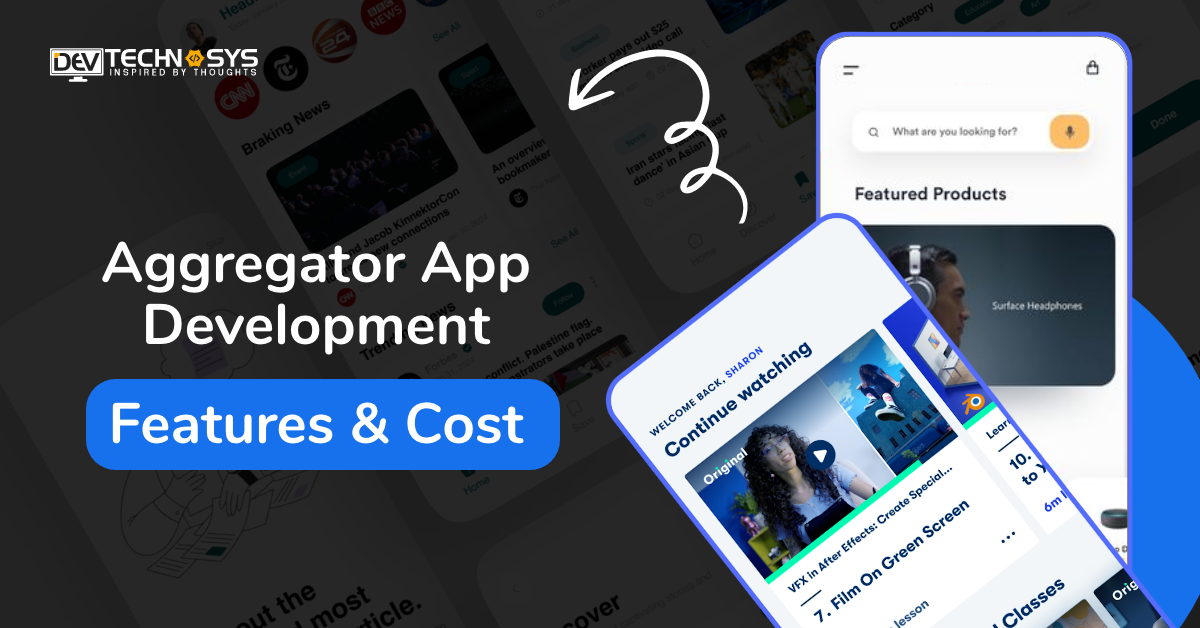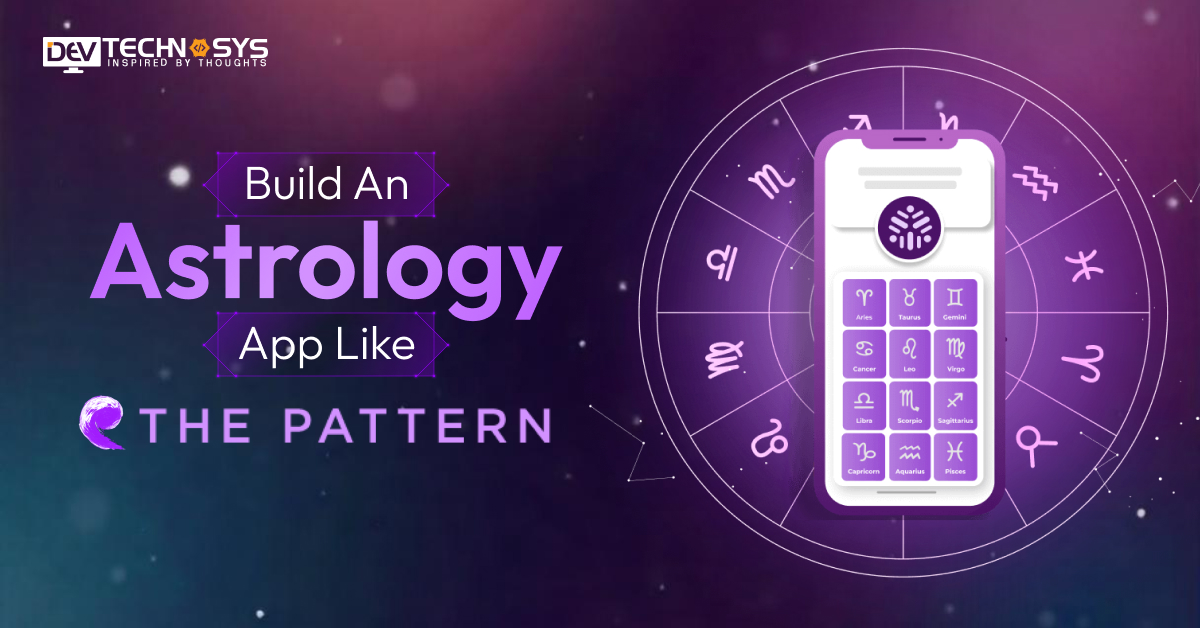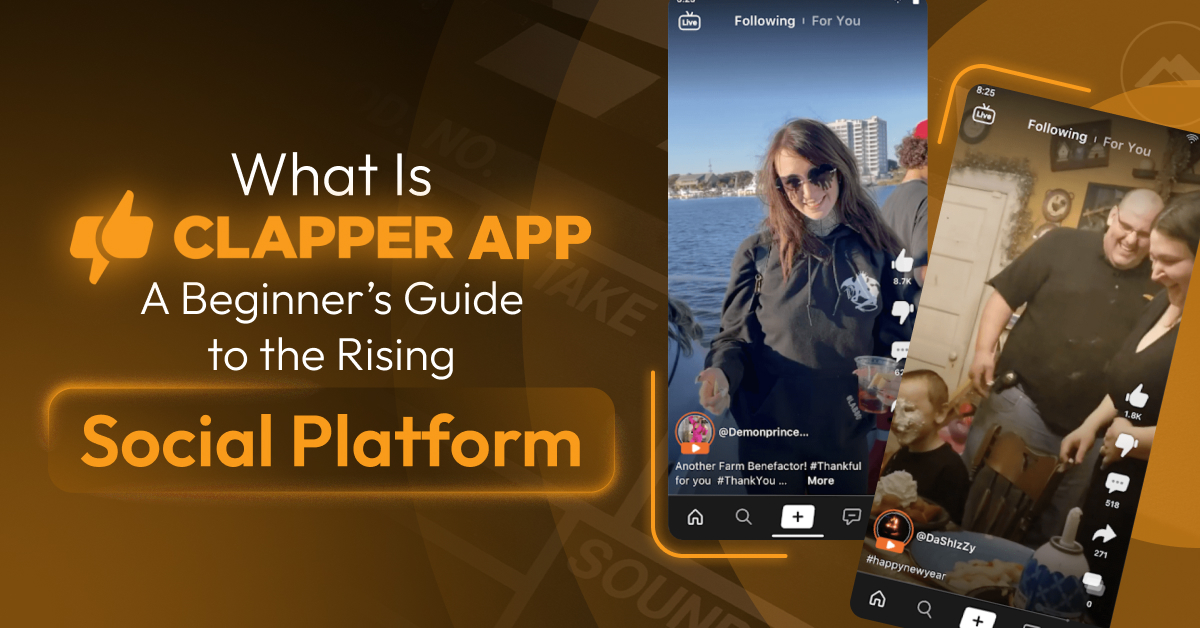Every day, millions of people around the world use platforms like Flipboard for news feeds, Spotify for music, Uber for rideshare services, and many more. Investing in aggregator app development is an ideal way to grow the client base and improve your business’s standing.
To get more visitors or even leads for your business, you can use an aggregator app. You can also sell these leads to other businesses that are listed on your aggregator.
Think about it again, there are already a few big aggregators that have millions of people. Is your idea of developing an aggregator app still useful? To get an answer, read this blog till the end. In this blog, we will go over the aggregator market, the process of Aggregator App Development, and how much it will cost to design your own custom aggregator.
So, let’s begin!
What is an Aggregator App?
An aggregator app takes goods or services from a number of different sellers and sells them in one place. Apps like Uber, Ola, and Airbnb are some of the best notable examples of aggregator apps. Most of the time, aggregators don’t own any factories or stores.
For instance, to compare the most recent news from several sources, launch the Flipboard app and read articles about the same topic from a variety of sources. So, if you are planning for aggregator app development, get in touch with a mobile app development company.
Is It Worth To Invest In Aggregator App Development?
- Even though it has raised 3.4 billion dollars in capital as of 2023, e-commerce unicorn Thrasio still beats out its rivals in the ranking of Amazon aggregators.
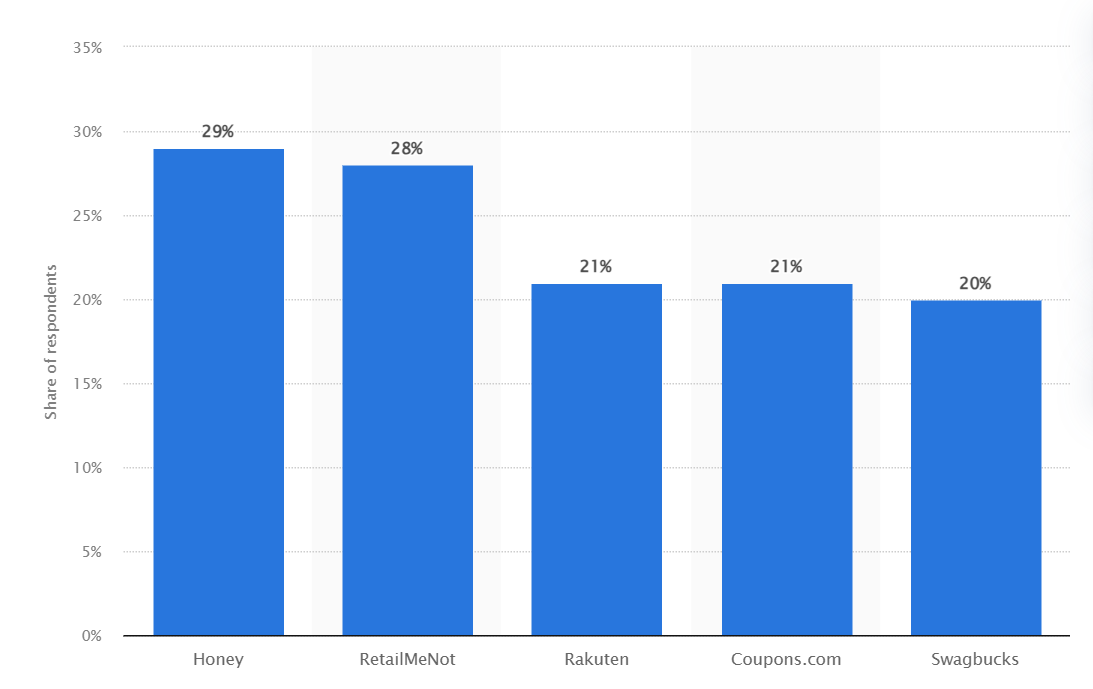
- With 28 percent, RetailMeNot came in second. Third place went to both Rakuten and Coupons.com, which were both used by 21% of customers.
- In 2023, the Tata Neu app had about 49 million downloads, making it the most famous discount and deal app in the world. After that came Too Good To Go, which got over 21 million downloads that year.
- It is expected that the market for itinerary organizers will be worth US$ 27 million in 2023 and US$ 55.6 million by 2033, growing at a rate of 7.5% per year.
How Does an Aggregator App Work?
Aggregator apps regulate between various service providers by bringing their various products and services together on a single platform. Users can get everything they need in one place, and service providers can reach more customers.
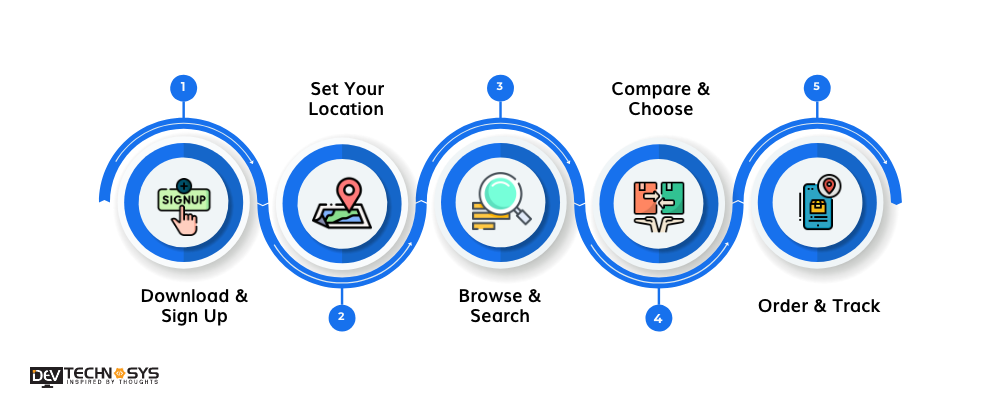
How they work and how to use them are explained here:
1. Download & Sign Up:
Install the aggregator app that works best for you (for example, food delivery or ride-hailing). Make an account.
2. Set Your Location:
You can either let the app know where you are or put your delivery or service address.
3. Browse & Search:
Look around the app’s layout. Browse by category or look for specific things, like restaurants that serve a certain type of food.
4. Compare & Choose:
See the menus, prices, scores, and reviews of different places to eat to find the best one for you.
5. Order & Track:
To schedule a service or place an order, utilize the app. Often, you can see how things are going (for example, when the food is being made or when the driver arrives).
Different Types of Aggregator Applications
First things first, before we go into aggregator app development. Let’s take a look at the different kinds of Aggregator apps out there.
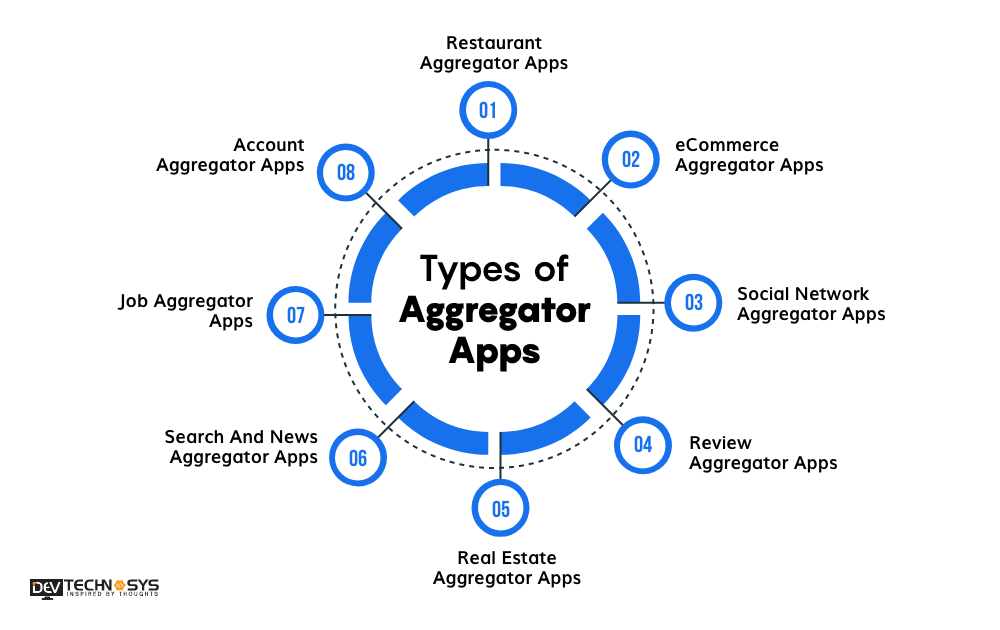
1. Restaurant Aggregator Apps
Just what you’d expect from the name: these applications facilitate the delivery of food. There are many restaurants, cloud kitchens, and other types of food places that these apps offer under one brand. With food delivery app development solutions, it makes it simple for users to compare foods and buy the ones they want.
Example: Zomato
2. eCommerce Aggregator Apps
eCommerce aggregator applications bring together a market with many different stores. Most of the time, ecommerce app development soluions are specialized in one area, like shopping for furniture, clothes, etc.
Example: Amazon
3. Social Network Aggregator Apps
These days, most people use more than one social media aggregator app. A unified experience lets them keep up with all the changes and actions happening across all of their accounts. This means that social network aggregator apps let them join different feeds and see all of the content in one place.
Example: Buffer
4. Review Aggregator Apps
It’s not easy for buyers to look for reviews on a lot of different websites. Review aggregator apps make it easy for customers to see feedback, scores, and reviews for a product, service, company, or business aggregator from a number of different review sites.
Example: Feedly
5. Real Estate Aggregator Apps
You can find aggregator tools in a lot of the most popular real estate app development solutions. On the same website, they list homes from many buyers, builders, renters, and real estate business owners. This makes it easier for buyers to find the best properties for them by filtering them based on their tastes and prices.
Example: Trulia
6. Search And News Aggregator Apps
They are better than search engines and work like search engines. These kinds of apps collect search results from different websites and search engines and put them all in one place.
This makes it easier for users to look into topics that interest them. This is also how most news apps work: they gather news and articles from different sources and post them on an RSS feed.
Example: Google News
7. Job Aggregator Apps
There are websites and apps that collect job postings and companies from a number of different job boards, hiring platforms, and other similar sites. These kinds of apps help people find the right jobs and help companies find the right people to work for them.
Example: LinkedIn
8. Account Aggregator Apps
The mobile banking app development business is aware of the rise of aggregator apps. This is a great way to alter different banking services into one. For example, you can use them to get account statements for loan applications, share information about multiple accounts, keep track of your money, add to your saves, pay off debts, and more.
Example: PhonePe
How Are Aggregator Apps Different from Marketplaces?
The way that aggregator apps work is different from the way that normal marketplace apps work. One example is that an aggregator platform might sell goods from many different types of businesses, but an aggregator usually only deals with one type of business. However, this is only one case.
Elements |
Aggregator App |
Marketplace |
| Control | Aggregators set terms, branding, and often pricing. | Seller sets branding, pricing, and manages customer interaction. |
| Brand | Services offered under aggregator’s brand. (e.g. Uber) | Multiple brands (sellers) present on the platform. (e.g. Amazon) |
| Focus | Seamless customer experience with standardized services. | Wide variety of options with focus on seller competition. |
| Pricing | Aggregators may set prices or take commission per transaction. | Sellers set their own prices. |
| Inventory/Services | Aggregator curates and manages service providers. | Marketplace connects buyers and sellers with independent inventory. |
| Quality Control | Aggregator prioritizes consistent quality across offerings. | Marketplace has varying quality based on individual sellers. Aggregators might introduce tiers (e.g. standard vs. deluxe). |
| Examples | Uber (taxis), Grubhub (food delivery) | Amazon, eBay, Etsy |
“Dev Technosys and our team worked together to make an aggregator app. Their team was simply outstanding. We were blown away by how well-made and easy to use the app they made, which shows how skilled they are in making aggregator apps and UX design. Our app is quickly becoming the tool of choice for our community, and people who use it are getting more involved. We highly recommend Dev Technosys.”
– James West
Major Steps of Aggregator App Development
After deciding what features to include in an aggregator app and locating a business, you can start the aggregator app development process. To do this, you need to follow a step-by-step plan to develop an aggregator app.
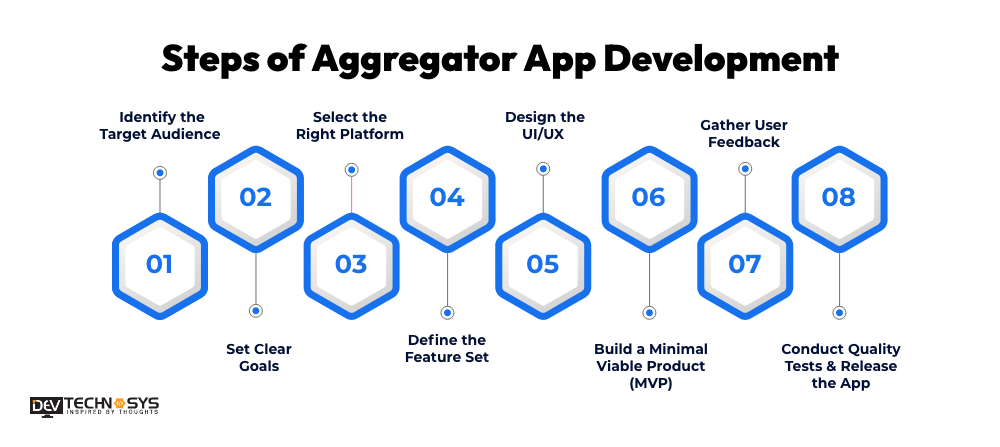
1. Identify the Target Audience
To find the target group, you need to look into the age, preferences, and buying habits of the ideal consumer to make sure the app meets their needs. A clear picture of the people you want to reach makes it easier to make products for the aggregator app development.
As an example, a B2B on demand app development company could let them buy bulk materials with just one click and get real-time updates on when their equipment will be delivered.
2. Set Clear Goals
Your business’s goals should help you make clear app goals. This will help you make the collection app and figure out how well it did after it came out. Additionally, this will assist you in figuring out which features are the most crucial and how to best utilize your assets to expand and adapt.
You should also think about what performance measures, like engagement, conversions, and sales growth, you will use to judge how well the app is doing. Statista shows a 25% rise in daily active users and a 15% rise in conversion rates are used to measure success.
3. Select the Right Platform
Your target audience’s device preferences will help you choose the best platform, whether it’s iOS, Android, or both. This choice affects how many people can use your app and how well it works when you create a mobile app.
For example, if most of your target audience uses iOS, putting your app first in Apple’s App Store could help it get more downloads and exposure.
4. Define the Feature Set
When choosing the features, it’s important to pick ones that fit with your business goals and what users want. In this way, you can make sure that your app gives users a good experience for aggregator app development.
For instance, an aggregator app for electronics might have full product descriptions, comparison tools, and customer reviews to help people make smart purchases.
5. Design the UI/UX
The UX and UI of your aggregator mobile app are very important to its success because they have a direct effect on the user experience.
Here’s how:
The UX design of an app looks at how the app feels overall and how easy it is for users to get things done. The UI design, on the other hand, looks at the specific parts of the app that users interact with, like buttons and icons.
For instance, a clothes brand’s aggregator mobile app might have a clean, simple UI and an easy-to-use UX that lets users quickly sort products by size, color, and style.
6. Build a Minimal Viable Product (MVP)
To start with MVP app development, you need to make a simple version of your mobile app that has only the most important features. With this focused method, you can get the product to market quickly and test your main idea in the real world.
For instance, the MVP of an app that combines shopping delivery might only include basic features like the ability to add items to a cart and a simple way to check out.
7. Gather User Feedback
After the MVP is released, it’s important to get feedback from users to figure out how well it works and where it could be improved. How are you going to get this feedback?
These details can be gathered by polls and user testing sessions with your own app development team or an outside Aggregator App Development Service provider.
For example, if people who use the brand-new aggregator app development have trouble finding their way around the product categories, the team can use that information to improve the UX design of the app in future updates.
8. Conduct Quality Tests & Release the App
During quality testing, the mobile app is carefully inspected for bugs, speed problems, and problems with the user experience. The mobile aggregator app is put on the market only after it has passed all quality tests and met all the requirements.
Which mobile app development company can you be sure will have good quality testing staff? When you work with an aggregator app development company, you can get access to the best quality testers who can make the best aggregators apps for your business.
9. App Maintenance & Support
As soon as the app is out there, it needs to keep getting better based on user feedback, user analytics, and mobile app success metrics. If information shows that food delivery app users frequently abandon their carts at the payment stage, the mobile app maintenance and support team could improve the checkout process by adding one-click payment options to make it easier for users.
Must-have Features of Aggregator App Development
An aggregator can have a lot of interesting and different features added to it. But these aren’t the first things you should look at. Most of the time, we tell founders to start with the features that the product can’t live without. And no matter what kind of aggregate you want to make, you’ll need these things in aggregator app development.
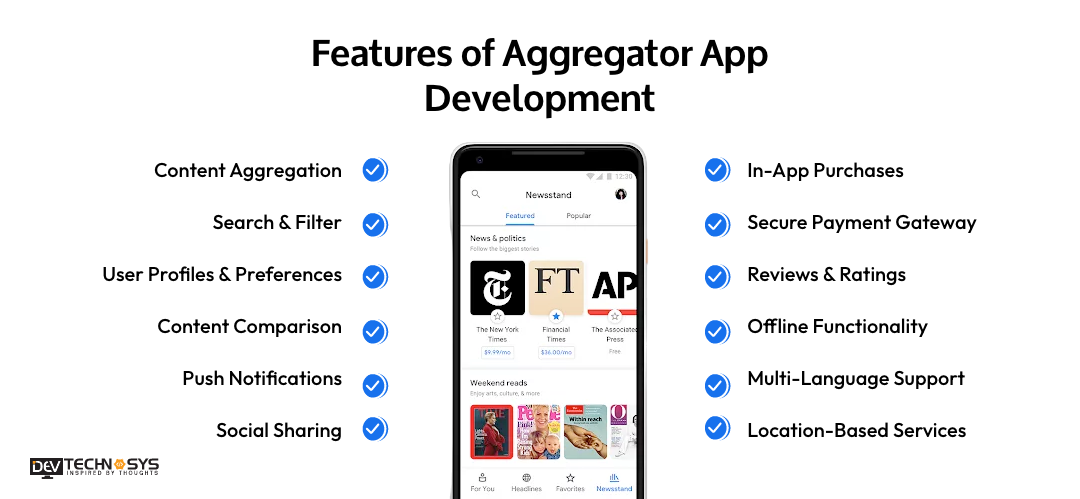
Features |
Descriptions |
| Content Aggregation | Getting news, products, and services from different places and putting them all on one site is its main job. |
| Search & Filter | Users can look for specific material and sort the results by different criteria. |
| User Profiles & Preferences | Allows users to make accounts, set preferences, and make their experience unique. |
| Content Comparison | Allows you to compare two or more goods, services, or news stories side by side. |
| Push Notifications | Sends alerts and updates in real time about news, deals, or the state of your order. |
| Social Sharing | With social media app development, allows people to share material with their social media friends and followers. |
| In-App Purchases | Allows app users to buy goods or services right from the app. |
| Secure Payment Gateway | If you add a payment gateway in the app, it allows users to make transactions on a safe site. |
| Reviews & Ratings | Review and rating tools let people write about goods, services, or content providers. |
| Offline Functionality | This function lets users see some material or features even when they’re not online. |
| Multi-Language Support | Offers the app’s interface and content in more than one language to reach a larger community. |
| Location-Based Services | Adapts information and suggestions based on where the user is (news, deals, services close by, etc.). |
Best Aggregator Apps in the Market
Knowing your rivals is one of the first things you should do for aggregator app development. It wasn’t possible for such a complicated aggregator to fill the need, so other aggregator services started to develop. So, here are the best apps that aggregate.
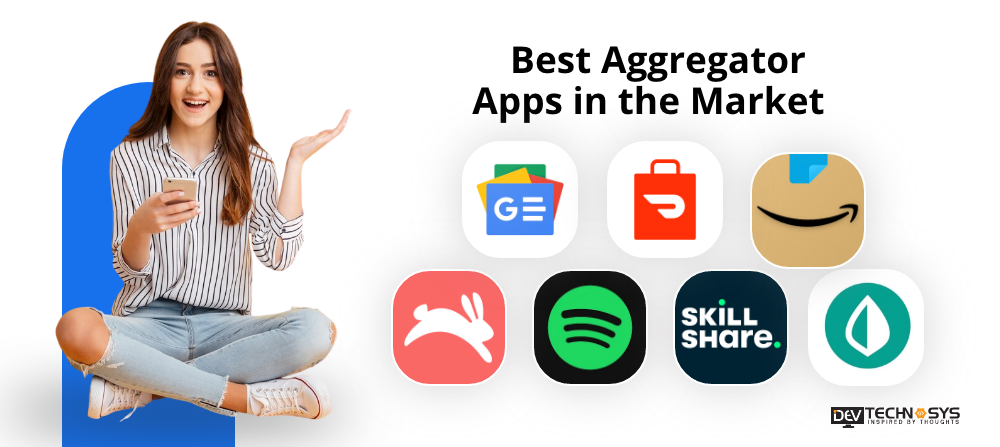
1. News: Google News
Google News is among the best news aggregator sites that gives you a clean and personalized way to read news.
2. Food Delivery: DoorDash
When it comes to food service, an app like DoorDash is the best. It has a huge number of restaurants, makes ordering easy, and lets you track your service in real time.
3. Travel: Hopper
Hopper helps you find the best deals when you travel. It looks at patterns and guesses how flight and hotel prices will change, which helps you book your dream trip at the best price.
4. Entertainment: Spotify
Spotify is the best service for streaming music, and it has a huge library of songs, podcasts, and videos. With Spotify entertainment app development, you can find new songs, make your own playlists, and listen online or off.
5. Learning: Skillshare
Through short, helpful online classes, Skillshare gives you the power to learn skills that are in demand.
6. Shopping: Amazon
Through its app, Amazon, the huge store chain, makes buying easier. You can look through millions of items, check prices, and get them quickly and reliably. With shopping app development, users can easily purchase different items on this aggregator app.
7. Finance: Mint
An app like Mint is where you can manage your money. It is the best account aggregator that brings together all of your bank accounts, credit cards, and bills so you can see your whole financial picture.
Benefits of Aggregator App Development
What next? Well, obviously how it benefits you. Here are the benefits of aggregator app development for business.
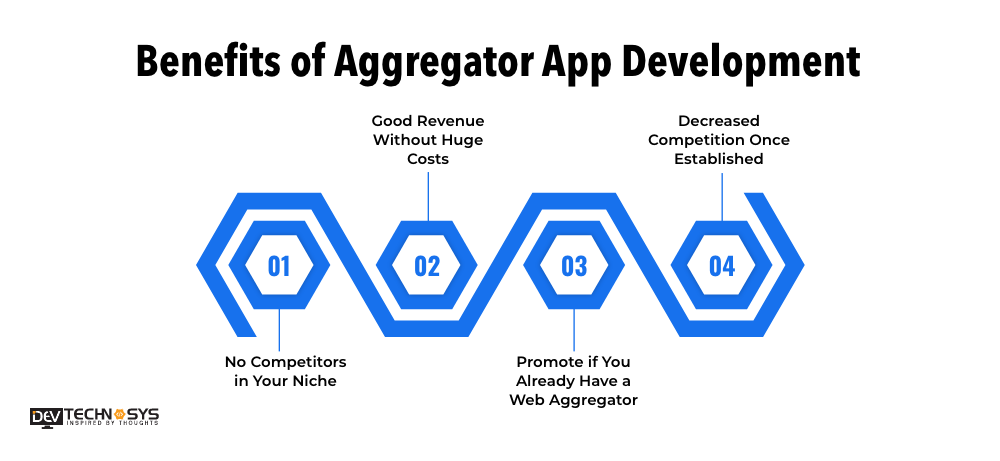
● No Competitors in Your Niche
Even if you’re in a niche market, it’s normal to have competition. If no one else has an idea like yours, it could mean that you came up with it first and no one else has thought of it yet.
For example, Amazon began by selling niche goods that were very specific. The business sold books in its first two years. Then CDs and videos were added. After a while, electronics, video games, furniture, clothes, and food came next. This is how Amazon became a market leader in both vertical and horizontal markets.
● Good Revenue Without Huge Costs
Aggregator apps don’t have to spend a lot of money on staff, ads, copywriters, and editors. This kind of app uses original material from other apps. Therefore, the app owner only has to think about the cost of putting in place the gathering technology.
Gathering apps can make a good profit this way. Take Feedly as an example. Its present value is $5.2 million, and Uber’s annual revenue was $11.5 billion in 2020.
● Promote if You Already Have a Web Aggregator
It becomes clear that businesses must create an app as they grow. This mix of strategies will help you figure out how to reach the most people and get them to sign up. Alibaba, for instance, has both a website and an app.
● Decreased Competition Once Established
Since aggregator app development solutions build a network and put a lot of work into building its brand, it can’t offer overnight success. But it won’t be easy for a new company to beat you once you have built a base of buyers and sellers and raised brand recognition.
How Much Does Aggregator App Development Cost?
First, we need to think about the cost to develop a mobile app for an aggregator. Location, app complexity, and the state of the local market can all affect the cost to create an aggregator app. An aggregator app development cost can be anything from $10,000 to $30,000, depending on all of these factors. I’ll give you a rough idea of how much each type of aggregator app costs below:
1. Hotel Aggregator App:
- Cost Range:$10,000 – $25,000+
- Factors Affecting Cost:Features, platform type, and location of the development team.
2. Taxi Aggregator App:
- Cost Range:$10,000 – $21,000+
- Factors Affecting Cost:Real-time tracking, estimating fares, integrating payments, and a complicated delivery system.
3. Real Estate Aggregator App:
- Cost Range:$13,000 – $24,000+
- Factors Affecting Cost:Integration with real estate databases, management of property listings, and search filters.
4. Online Shopping Aggregator App:
- Cost Range:$15,000 – $26,000+
- Factors Affecting Cost:Adding product info from several stores, comparing prices, and safe payment processing.
5. News Aggregator App:
- Cost Range:$8,000 – $20,000+
- Factors Affecting Cost:You can add content curation algorithms, integration of news sources, and push alerts features in news app development.
6. Food Delivery Aggregator App:
- Cost Range:$11,000 – $28,000+
- Factors Affecting Cost:Order tracking, restaurant integration, and delivery control in real time.
This is just a guess, remember. The final cost may change based on your requirements and the development team you hire.
Key Trends To Follow For Aggregator App Development
Aggregator apps are becoming ever more vital to help people keep track of all the data that comes in all the time. For aggregator apps to stay ahead of the game, here are some important trends to keep in mind:
-
Personalization with AI:
The days of a cookie-cutter strategy are over. Users want experiences that are tailored to them. ML and AI development solution should be used together to choose material for each person.
-
Actionable Insights:
Don’t just collect knowledge; make it useful. One-click purchases, making meetings, and adding things to to-do lists are some examples of this.
-
Voice Search and Control:
Voice interaction is very hot right now. Voice commands can be used to search for material, move around in the app, and even control playback.
-
Content Summarization and Curation:
With so much knowledge available, we are losing the ability to focus for longer periods of time. Build in tools that summarize articles, and draw attention to important points.
-
Seamless Multi-Device Integration:
During the day, people use many gadgets. Always assure that your mobile app operates well on all devices. Like phones, tablets, computers, and even smart gadgets.
Let’s Create An Aggregate App With Minimal Budget!
That’s all there is to know about aggregator app development. We hope that the blog was interesting and useful for you. You can start making your own aggregator app for your favorite area once you’ve found inspiration.
You can either make an aggregator app from the start or upload an existing aggregator app. You can also make apps from scratch that are completely unique to you with the help of a dedicated developer.
Choose one, and then use simple point-and-click tools to build your app. Before you develop your app, you should look at the project requirements first. Only then should you upgrade to publish your app. Get in touch with us to find out!
FAQs
1. What are Aggregators?
People who assemble aggregators gather information from different sources and put it all in one place.
2. How to Build an Aggregator Website?
To develop an aggregator website, follow the steps:
- Pick your niche
- Choose your platform
- Find your sources
- Design and curate
- Launch and maintain
3. How Long Will It Take To Build An Aggregator App?
The development time for an aggregator app can be between 2-4 months for a simple app. It can increase to 8 months for a complex app.
4. How Much Does It Cost To Develop An Aggragtor App?
The cost to build an aggregator app depends on many factors. Here is the breakdown
- Basic features: $10,000 – $15,000
- Complex features: $15,000 – $22,000+
- Advanced features (AI, ML): $30,000+
